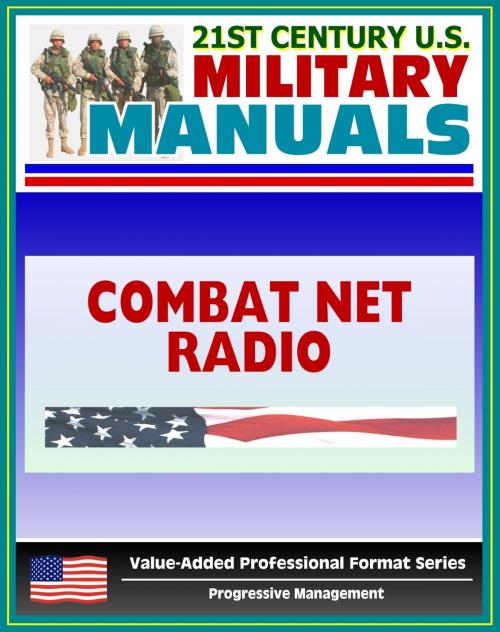21st Century U.S. Military Manuals: Combat Net Radio Operations (FM 11-32) SINCGARS, Battlefield Radio (Value-Added Professional Format Series)
Nonfiction, Science & Nature, Technology, Military Science, Social & Cultural Studies, Political Science| Author: | Progressive Management | ISBN: | 9781465857262 |
| Publisher: | Progressive Management | Publication: | September 9, 2011 |
| Imprint: | Smashwords Edition | Language: | English |
| Author: | Progressive Management |
| ISBN: | 9781465857262 |
| Publisher: | Progressive Management |
| Publication: | September 9, 2011 |
| Imprint: | Smashwords Edition |
| Language: | English |
Professionally converted for accurate flowing-text e-book format reproduction, the Combat Net Radio Operations Field Manual (FM 11-32) covers the use of single-channel radios on the modern battlefield.
In the preface, it states:
"This manual serves as a reference document for combat net radio (CNR) systems. It does not replace field manuals governing combat, combat support (CS), or combat service support (CSS) unit tactical deployment or technical manuals on equipment use. This manual provides guidance for using single channel radios on the modern battlefield. It addresses planning and operating techniques and considerations to ensure full interoperability of new generation frequency-hopping (FH) radios with the previous generation and with allied nation single-channel radios. It also addresses FH radios in the single-channel mode. This manual describes new systems being fielded and provides specific doctrinal uses for each of those systems. This manual describes equipment setups and planning steps for CNR systems. It also suggests items to consider for battalion and brigade standing operating procedures (SOPs). This manual is intended for operators, supervisors, and planners to provide a common reference for new CNR radios. It gives operators and supervisors basic guidance and operating instructions. It also gives the system planner the necessary steps for network planning, interoperability considerations, and equipment capabilities."
Some highlights of the contents:
"Modern semiconductor technology has made high-speed signal processing part of everyday life and has enhanced communications systems capabilities. Adding electronic counter-countermeasures (ECCM) modules and devices makes radios and command and control (C2) facilities more survivable. Frequency hopping (FH) is a spread-spectrum radio technique. It degrades enemy forces' abilities to find, monitor, or destroy friendly systems. Single-channel radios are being upgraded or replaced. This provides the maneuver force commander with a reliable multifaceted C2 communications system. The combination of high frequency (HF), very high frequency (VHF), and ultra high frequency (UHF) radios gives commanders redundant, but different, means to control their forces. Each system takes advantage of a different transmission path increasing the probability that at least one communications system will work at any given time. Joining active electronic and passive ECCM techniques with multiple radio sets in the C2 system provides effective communications to control ground and airborne forces. However, the increase in complexity and number of different radio types also increases the predeployment planning necessary to ensure completely operational communications networks. The CNR network is designed around three separate radio systems. Each system has different capabilities and transmission characteristics. The three systems are Improved high frequency radio (IHFR); Single-Channel Ground and Airborne Radio System (SINCGARS); and Single-channel tactical satellite (TACSAT)."
This manual is produced by Headquarters, US Army Training and Doctrine Command (TRADOC).
As a bonus, this reproduction includes FM-1, The Army Field Manual, a capstone manual containing the vision for the Army - sold separately for $5.99. FM 1 establishes the fundamental principles for employing Landpower. The most important of these are the Army's operational concept and the fundamentals that support it. They form the foundation for all Army doctrine. All Soldiers should understand and internalize them. FM 1 describes the American profession of arms, the Army's place in it, and what it means to be a professional Soldier.
This is a privately authored news service and educational publication of Progressive Management.
Professionally converted for accurate flowing-text e-book format reproduction, the Combat Net Radio Operations Field Manual (FM 11-32) covers the use of single-channel radios on the modern battlefield.
In the preface, it states:
"This manual serves as a reference document for combat net radio (CNR) systems. It does not replace field manuals governing combat, combat support (CS), or combat service support (CSS) unit tactical deployment or technical manuals on equipment use. This manual provides guidance for using single channel radios on the modern battlefield. It addresses planning and operating techniques and considerations to ensure full interoperability of new generation frequency-hopping (FH) radios with the previous generation and with allied nation single-channel radios. It also addresses FH radios in the single-channel mode. This manual describes new systems being fielded and provides specific doctrinal uses for each of those systems. This manual describes equipment setups and planning steps for CNR systems. It also suggests items to consider for battalion and brigade standing operating procedures (SOPs). This manual is intended for operators, supervisors, and planners to provide a common reference for new CNR radios. It gives operators and supervisors basic guidance and operating instructions. It also gives the system planner the necessary steps for network planning, interoperability considerations, and equipment capabilities."
Some highlights of the contents:
"Modern semiconductor technology has made high-speed signal processing part of everyday life and has enhanced communications systems capabilities. Adding electronic counter-countermeasures (ECCM) modules and devices makes radios and command and control (C2) facilities more survivable. Frequency hopping (FH) is a spread-spectrum radio technique. It degrades enemy forces' abilities to find, monitor, or destroy friendly systems. Single-channel radios are being upgraded or replaced. This provides the maneuver force commander with a reliable multifaceted C2 communications system. The combination of high frequency (HF), very high frequency (VHF), and ultra high frequency (UHF) radios gives commanders redundant, but different, means to control their forces. Each system takes advantage of a different transmission path increasing the probability that at least one communications system will work at any given time. Joining active electronic and passive ECCM techniques with multiple radio sets in the C2 system provides effective communications to control ground and airborne forces. However, the increase in complexity and number of different radio types also increases the predeployment planning necessary to ensure completely operational communications networks. The CNR network is designed around three separate radio systems. Each system has different capabilities and transmission characteristics. The three systems are Improved high frequency radio (IHFR); Single-Channel Ground and Airborne Radio System (SINCGARS); and Single-channel tactical satellite (TACSAT)."
This manual is produced by Headquarters, US Army Training and Doctrine Command (TRADOC).
As a bonus, this reproduction includes FM-1, The Army Field Manual, a capstone manual containing the vision for the Army - sold separately for $5.99. FM 1 establishes the fundamental principles for employing Landpower. The most important of these are the Army's operational concept and the fundamentals that support it. They form the foundation for all Army doctrine. All Soldiers should understand and internalize them. FM 1 describes the American profession of arms, the Army's place in it, and what it means to be a professional Soldier.
This is a privately authored news service and educational publication of Progressive Management.















